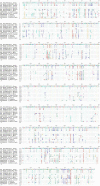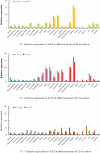Characteristics of Angiotensin I-converting enzyme 2, type II transmembrane serine protease 2 and 4 in tree shrew indicate it as a potential animal model for SARS-CoV-2 infection
- PMID: 34227905
- PMCID: PMC8806782
- DOI: 10.1080/21655979.2021.1940072
Characteristics of Angiotensin I-converting enzyme 2, type II transmembrane serine protease 2 and 4 in tree shrew indicate it as a potential animal model for SARS-CoV-2 infection
Abstract
Angiotensin I-converting enzyme 2 (ACE2), type II transmembrane serine protease 2 and 4 (TMPRSS2 and TMPRSS4) are important receptors for SARS-CoV-2 infection. In this study, the full-length tree shrewACE2 gene was cloned and sequenced, and its biological information was analyzed. The expression levels of ACE2, TMPRSS2 and TMPRSS4 in various tissues or organs of the tree shrew were detected. The results showed that the full-length ACE2 gene in tree shrews was 2,786 bp, and its CDS was 2,418 bp, encoding 805 amino acids. Phylogenetic analysis based on the CDS of ACE2 revealed that tree shrews were more similar to rabbits (85.93%) and humans (85.47%) but far from mice (82.81%) and rats (82.58%). In silico analysis according to the binding site of SARS-CoV-2 with the ACE2 receptor of different species predicted that tree shrews had potential SARS-CoV-2 infection possibility, which was similar to that of rabbits, cats and dogs but significantly higher than that of mice and rats. In addition, various tissues or organs of tree shrews expressed ACE2, TMPRSS2 and TMPRSS4. Among them, the kidney most highly expressed ACE2, followed by the lung and liver. The esophagus, lung, liver, intestine and kidney had relatively high expression levels of TMPRSS2 and TMPRSS4. In general, we reported for the first time the expression of ACE2, TMPRSS2 and TMPRSS4 in various tissues or organs in tree shrews. Our results revealed that tree shrews could be used as a potential animal model to study the mechanism underlying SARS-CoV-2 infection.
Keywords: ACE2; TMPRSS2; TMPRSS4; Tree shrew; tissue expression.
Conflict of interest statement
No potential conflict of interest was reported by the author(s).
Figures









Similar articles
-
Nasopharyngeal Expression of Angiotensin-Converting Enzyme 2 and Transmembrane Serine Protease 2 in Children within SARS-CoV-2-Infected Family Clusters.Microbiol Spectr. 2021 Dec 22;9(3):e0078321. doi: 10.1128/Spectrum.00783-21. Epub 2021 Nov 3. Microbiol Spectr. 2021. PMID: 34730438 Free PMC article.
-
Obesogenic and Ketogenic Diets Distinctly Regulate the SARS-CoV-2 Entry Proteins ACE2 and TMPRSS2 and the Renin-Angiotensin System in Rat Lung and Heart Tissues.Nutrients. 2021 Sep 25;13(10):3357. doi: 10.3390/nu13103357. Nutrients. 2021. PMID: 34684358 Free PMC article.
-
Expression of ACE2 and TMPRSS2 Proteins in the Upper and Lower Aerodigestive Tracts of Rats: Implications on COVID 19 Infections.Laryngoscope. 2021 Mar;131(3):E932-E939. doi: 10.1002/lary.29132. Epub 2020 Oct 19. Laryngoscope. 2021. PMID: 32940922
-
Contributions of human ACE2 and TMPRSS2 in determining host-pathogen interaction of COVID-19.J Genet. 2021;100(1):12. doi: 10.1007/s12041-021-01262-w. J Genet. 2021. PMID: 33707363 Free PMC article. Review.
-
Polymorphisms and mutations of ACE2 and TMPRSS2 genes are associated with COVID-19: a systematic review.Eur J Med Res. 2022 Feb 22;27(1):26. doi: 10.1186/s40001-022-00647-6. Eur J Med Res. 2022. PMID: 35193695 Free PMC article.
Cited by
-
A SARS-CoV-2 related signature that explores the tumor microenvironment and predicts immunotherapy response in esophageal squamous cell cancer.Aging (Albany NY). 2023 Oct 6;15(19):10501-10523. doi: 10.18632/aging.205090. Epub 2023 Oct 6. Aging (Albany NY). 2023. PMID: 37812215 Free PMC article.
-
Peptide candidates for the development of therapeutics and vaccines against β-coronavirus infection.Bioengineered. 2022 Apr;13(4):9435-9454. doi: 10.1080/21655979.2022.2060453. Bioengineered. 2022. PMID: 35387556 Free PMC article. Review.
-
EV-A71 invades the central nervous system and affects the blood-brain barrier in a tree shrew model.Front Immunol. 2025 Jun 26;16:1583768. doi: 10.3389/fimmu.2025.1583768. eCollection 2025. Front Immunol. 2025. PMID: 40642060 Free PMC article.
-
Animal models for SARS-CoV-2 infection and pathology.MedComm (2020). 2021 Nov 16;2(4):548-568. doi: 10.1002/mco2.98. eCollection 2021 Dec. MedComm (2020). 2021. PMID: 34909757 Free PMC article. Review.
References
-
- Zhang H, Wada J, Hida K, et al. Collectrin, a collecting duct-specific transmembrane glycoprotein, is a novel homolog of ACE2 and is developmentally regulated in embryonic kidneys. J Biol Chem. 2001;276:17132–17139. - PubMed
-
- Donoghue M, Hsieh F, Baronas E, et al. A novel angiotensin-converting enzyme-related carboxypeptidase (ACE2) converts angiotensin I to angiotensin 1-9. Circ Res. 2000;87:E1–9. - PubMed
MeSH terms
Substances
LinkOut - more resources
Full Text Sources
Medical
Miscellaneous
